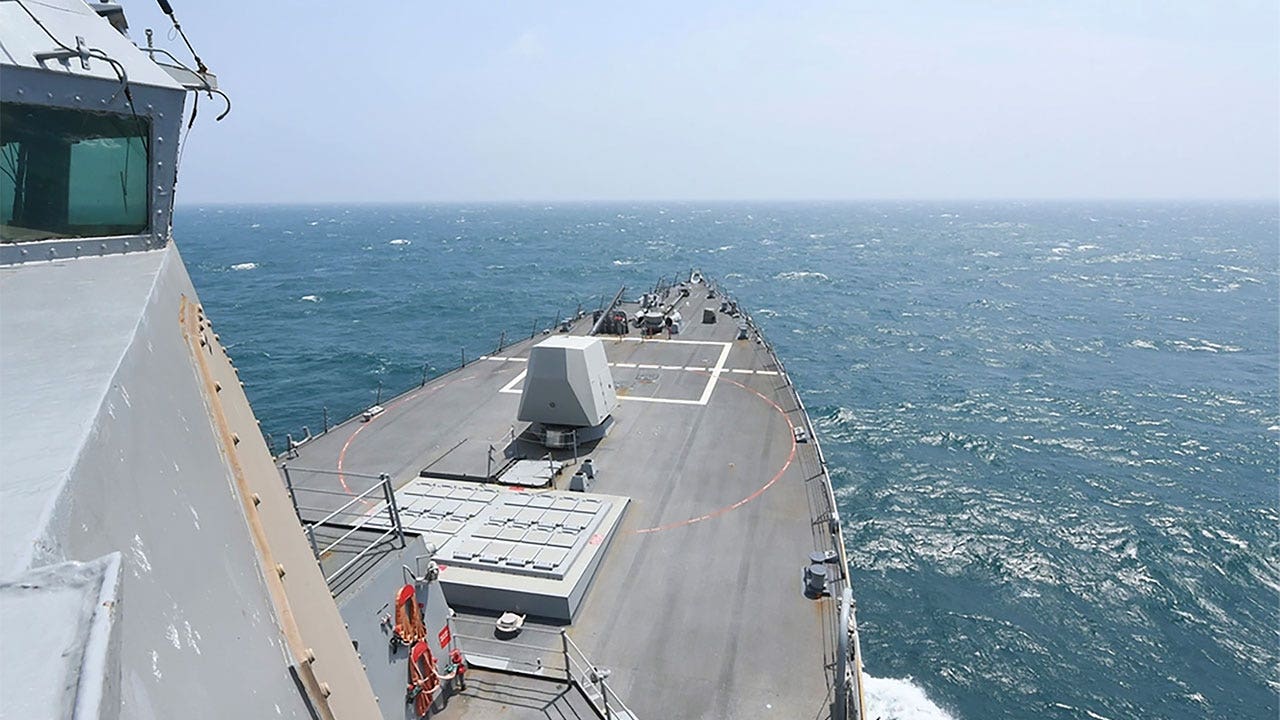- China’s military has criticized the passage of the USS Halsey through the Taiwan Strait, alleging that the U.S. hyped the event for political reasons.
- The U.S. Navy’s 7th Fleet defended the passage, saying it was routine and in accordance with international law.
- The Taiwan Strait, critical for global trade, serves as a point between China and nations like the U.S. and Britain.
China’s military criticized a U.S. destroyer’s passage through the Taiwan Strait less than two weeks before the island’s new president takes office and while Washington and Beijing are making uneven efforts to restore regular military exchanges.
Navy Senior Capt. Li Xi, spokesperson for China’s Eastern Theater Command, accused the U.S. of having “publicly hyped” the passage of the USS Halsey on Wednesday. In a statement, Li said the command, which oversees operations around the strait, “organized naval and air forces to monitor” the ship’s transit.
The U.S. Navy’s 7th Fleet said the Halsey “conducted a routine Taiwan Strait transit on May 8 through waters where high-seas freedoms of navigation and overflight apply in accordance with international law.”
TAIWAN STANDS AS MAJOR LINE OF DEFENSE AGAINST GLOBAL WAR WITH CHINA, CRITICAL FOR US SECURITY
The guided-missile destroyer transited through a corridor in the strait that is “beyond the territorial sea” of any coastal state, the fleet said in a statement.

The Arleigh Burke-class guided-missile destroyer USS Halsey (DDG 97) conducts routine underway operations while transiting through the Taiwan Strait on May 8, 2024. China’s military criticized a U.S. destroyer’s passage through the Taiwan Strait less than two weeks before the island’s new president takes office and while Washington and Beijing are making uneven efforts to restore regular military exchanges. (Mass Communication Specialist 3rd class Ismael Martinez/U.S. Navy via AP)
“Halsey’s transit through the Taiwan Strait demonstrates the United States’ commitment to upholding freedom of navigation for all nations as a principle,” it said. “No member of the international community should be intimidated or coerced into giving up their rights and freedoms. The United States military flies, sails, and operates anywhere international law allows.”
China’s accusation that the transit was “publicly hyped” — essentially meaning it was played up for maximum political effect — has been standard practice when Beijing sees the announcements as a means of pushing back against China’s claim to some degree of control over who can pass freely through the strait. There was no indication the U.S. Navy had operated any differently in the latest case, nor that the Chinese response was any more vociferous.
Taiwan’s Defense Ministry said it was fully aware of the destroyer’s passage.
CHINA INCREASES AGGRESSIVE MOVES AGAINST TAIWAN AS ISLAND PREPARES TO INAUGURATE NEW PRESIDENT
“Throughout the transit, the Taiwanese military was closely monitoring the surrounding sea and airspace, and the situation remained normal,” the ministry said.
The last such passage was on April 17, a day after U.S. and Chinese defense chiefs held their first talks since November 2022 in an effort to reduce regional tensions. Military-to-military contact stalled in August 2022, when Beijing suspended all such communication after then-House Speaker Nancy Pelosi visited Taiwan. China responded by firing missiles over Taiwan and staging a surge in military maneuvers, including what appeared to be a rehearsal of a naval and aerial blockade of the island.
The critical strait is 100 miles wide and divides China from Taiwan, the self-governing island democracy where President-elect William Lai Ching-te will be inaugurated on May 20. Lai’s Democratic Progressive Party favors Taiwan’s de facto independent status under which it maintains strong unofficial relations with the U.S. and other major nations.
Taiwan’s military heightens its alert status around sensitive dates, such as this January’s presidential and legislative elections, wary that China might use its vastly more powerful military to attempt to intimidate voters and sway public opinion in favor of Beijing’s insistence that unification between the sides is inevitable.
The two sides split during a civil war in 1949, and as recently as 1996, China fired missiles just north and south of the island and held military exercises in an ultimately counterproductive bid to deter voters from backing candidates they opposed. Since then, China has largely kept a low profile around elections, favoring instead to curry favor with business groups and treat unification-oriented politicians and grassroots officials to all-expenses paid visits to the mainland.
Although the heavily transited Taiwan Strait is international waters and vital to global trade, China considers the passage of warships from the U.S., Britain and other nations as a challenge to its sovereignty.
China sends navy ships and warplanes into the strait and other areas around the island almost daily to wear down Taiwan’s defenses and seek to intimidate its 23 million people, who firmly back their de facto independence.
CLICK HERE TO GET THE FOX NEWS APP
Taiwan’s Defense Ministry said 23 Chinese military aircraft and eight naval ships were detected operating around Taiwan in the 24 hours up to 6 a.m. Thursday. Eight of the planes crossed the median line in the strait and entered Taiwan’s air defense identification zone, prompting Taiwan to scramble jets and put coastal missile batteries and naval craft on alert.
In addition to sailing through the Taiwan Strait, the U.S. Navy conducts what it calls freedom of navigation operations in which it sails and flies in close proximity to Chinese-held features in the South China Sea, many of them human-made islands that have been ‘militarized over the years with air strips, radar stations and other capabilities.
China claims virtually all of the South China Sea, a principal maritime highway for global trade, and reacts furiously to such moves, accusing the U.S. of destabilizing the region. It often shadows the U.S. vessels and planes with its own assets, demanding they leave the area immediately. The U.S. claims it has the right under international law to sail in the area and a U.N.-backed arbitration panel has tossed out China’s claims, a ruling Beijing ignored.






